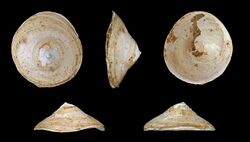Biology:Calyptraea chinensis
| Calyptraea chinensis | |
|---|---|

| |
| Scientific classification | |
| Kingdom: | |
| Phylum: | |
| Class: | |
| (unranked): | |
| Superfamily: | Calyptraeoidea
|
| Family: | |
| Genus: | |
| Species: | C. chinensis
|
| Binomial name | |
| Calyptraea chinensis (Linnaeus, 1758)
| |
| Synonyms[1] | |
|
Calyptraea sinensis (Linnaeus, 1758) | |
Calyptraea chinensis, common name the Chinese hat snail or Chinese hat shell, is a species of small sea snail, a marine gastropod mollusk in the family Calyptraeidae, the slipper snails or slipper limpets, cup-and-saucer snails, and Chinese hat snails.[1][2]
Description
The thin shell of this species has the shape of an almost symmetrical cone (like a Chinese hat or conical Asian hat), 7 mm high and 15 – 21 mm wide. The internal partition has a spirally curved edge which runs running from the apex to the margin of the shell, and partly covers the aperture. The presence of this internal shelf distinguishes this species easily from the true limpets. The aperture is round and adapted to the substrate. The shell is creamy white, and glossy on the inside.
Calyptraea chinensis is a filter feeder, binding fine food particles with mucus. Like all slipper limpets, this species is a protandrous hermaphrodite, but the stages of change from male to female have not been clearly defined. Unlike Crepidula fornicata (the American slipper limpet), this species does not form stacks. The males and females only come together for copulation.[3] The species does not have a pelagic larval phase. The veliger stage is passed in capsules fixed to the substrate, and guarded under the shell of the parent. The young hatch as crawling post-veliger larvæ.[4]
Distribution
Calyptraea chinensis occurs in North-West Africa, in the Mediterranean, the North Sea, the Black Sea and the Atlantic Ocean. These small snails can be found in the littoral and sublittoral zones along sheltered, rocky shores and on muddy or silty areas as long as they can cling to a hard substrate such as stones, living oysters [5] and other shells. The species also occurs on the northern and western coasts of Britain and Ireland, but is absent from the North Sea and the English Channel.
Calyptraea chinensis is known in fossil state from the Pliocene and the Early Pleistocene.[6]
References
- ↑ 1.0 1.1 Calyptraea chinensis (Linnaeus, 1758). Gofas, S. (2009). Calyptraea chinensis (Linnaeus, 1758). In: Bouchet, P.; Gofas, S.; Rosenberg, G. (2009) World Marine Mollusca database. Accessed through the World Register of Marine Species at http://www.marinespecies.org/aphia.php?p=taxdetails&i on 2010-06-03 .
- ↑ Collins pocket guide, Sea Shore of Britain and Europe, HarperCollinsPublishers, London, 1996, ISBN:0-00-219955-6
- ↑ Wyatt, H. V. (1961). "The Reproduction, Growth, and Distribution of Calyptraea chinensis (L.)". Journal of Animal Ecology 30 (2): 283–302. doi:10.2307/2299.
- ↑ Wyatt, H.V. (April 1960). "Response of Larvæ of Calyptraea chinensis (L) to Light". Nature 186 (328): 328. doi:10.1038/186328a0.
- ↑ Minchin, D.; J.D. Nunn (April 2006). "Further Range Extensions of the Marine Gastropod Calyptraea chinensis (L.) in Ireland". The Irish Naturalists' Journal 28 (5): 200–203.
- ↑ Norton P.E.P., Marine Molluscan Assemblages in the Early Pleistocene of Sidestrand, Bramerton and the Royal Society Borehole at Ludham, Norfolk, Philosophical Transactions of the Royal Society of London. Series B, Biological Sciences, Vol. 253, No. 784 (Dec. 21, 1967), pp. 161-200
Wikidata ☰ Q2133952 entry
 |


